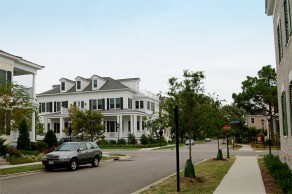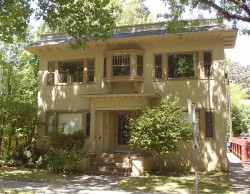Unfortunately, the solution is not as simple as adding more multi-family housing stock using the dated models/types of housing that we have been building. Rather, we need a complete paradigm shift in the way that we design, locate, regulate, and develop homes. As What’s Next states, “It’s a time to rethink and evolve, reinvent, and renew.” Missing Middle housing types, such as duplexes, fourplexes, bungalow courts, mansion apartments, and live/work units, are a critical part of the solution and should be a part of every architect’s, planner’s, real estate agent’s, and developer’s arsenal.
Well-designed, simple Missing Middle housing types achieve medium-density yields and provide high-quality, marketable options between the scales of single-family homes and mid-rise flats for walkable urban living. They are designed to meet the specific needs of shifting demographics and the new market demand, and are a key component to a diverse neighborhood. They are classified as “missing” because very few of these housing types have been built since the early 1940s due to regulatory constraints, the shift to auto-dependent patterns of development, and the incentivization of single-family home ownership.

The following are defining characteristics of Missing Middle housing:
A walkable context. Probably the most important characteristic of these types of housing is that they need to be built within an existing or newly created walkable urban context. Buyers or renters of these housing types are choosing to trade larger suburban housing for less space, no yard to maintain, and proximity to services and amenities such as restaurants, bars, markets, and often work. Linda Pruitt of the Cottage Company, who is building creative bungalow courts in the Seattle area, says the first thing her potential customers ask is, “What can I walk to?” So this criteria becomes very important in her selection of lots and project areas, as is it for all Missing Middle Housing.
Medium density but lower perceived densities. As a starting point, these building types typically range in density from 16 dwelling units per acre (du/acre) to up to 35 du/acre, depending on the building type and lot size. It is important not to get too caught up in the density numbers when thinking about these types. Due to the small footprint of these types of building and the fact that they are usually mixed with a variety of building types, even on an individual block, the perceived density is usually much lower—they do not look like dense buildings.
A combination of these types brings a neighborhood to a minimum average of 16 du/acre. This is important because that is generally considered to be a threshold at which an environment becomes transit-supportive and main streets with neighborhood-serving, walkable retail and services become viable.
Small footprint and blended densities. As mentioned above, a common characteristic of these housing types are small- to medium-sized building footprints. The largest of these types, the mansion apartment or side-by-side duplex, may have a typical main body width of about 40 to 50 feet, which is very comparable to a large estate home. This makes them ideal for urban infill, even in older neighborhoods that were originally developed as single-family but have been designated to evolve with slightly higher intensities. As a good example, a courtyard housing project in the Westside Guadalupe Historic District of Santa Fe, NM, sensitively incorporates six units and a shared community-room building onto a quarter acre lot. In this project, the buildings are designed to be one room deep to maximize cross ventilation and passive cooling and to enable the multiple smaller structures to relate well to the existing single-family context.
Smaller, well-designed units. One of the most common mistakes made by architects or builders new to the urban housing market is trying to force suburban unit types and sizes into urban contexts and housing types. The starting point for Missing Middle housing needs to be smaller unit sizes; the challenge is to create small spaces that are well designed, comfortable, and usable. As an added benefit, smaller unit sizes can help developers keep their costs down, improving the pro forma performance of a project, while keeping the housing at a lower price point, making it affordable to a larger group of buyers or renters.

Off-street parking does not drive the site plan. The other non-starter for Missing Middle housing is trying to provide too much parking on site. This ties back directly to the fact that these units are being built in a walkalble urban context. The buildings become very inefficient from a development potential or yield standpoint, shifting neighborhoods below the 16 du/acre density threshold, as discussed above, if large parking areas are provided or required. As a starting point, these units should provide no more than one off-street parking space per unit. A good example of this are the newly constructed mansion apartments in the East Beach neighborhood in Norfolk, Virginia. To enable these lower off-street parking requirements to work, on-street parking must be available adjacent to the units. Housing design that forces too much parking on a site also compromises the occupant’s experience of entering the building or “coming home” and the relationship with its context, especially in an infill condition, which can greatly impact marketability.
Simple construction. The days of easily financing and building complicated, expensive Type I or II buildings with podium parking are behind us, and an alternative for providing walkable urban housing with more of a simple, cost-effective construction type is necessary in many locations. What’s Next states, “affordability—always a key element in housing markets—is taking on a whole new meaning as developers reach for ways to make attractive homes within the means of financially constrained buyers.” Because of their simple forms, smaller size, and Type V construction, Missing Middle building types can help developers maximize affordability and returns without compromising quality by providing housing types that are simple and affordable to build.
Creating Community. Missing Middle housing creates community through the integration of shared community spaces within the types, as is the case for courtyard housing or bungalow courts, or simply from the proximity they provide to the community within a building and/or the neighborhood. This is an important aspect, in particular within the growing market of single-person households (which today is nearly 30% of all households) that want to be part of a community. This has been especially true for single women who have proven to be a strong market for these Missing Middle housing types, in particular bungalow courts and courtyard housing.

Marketability. The final and maybe the most important characteristic in terms of market viability is that these housing types are very close in scale and provide a similar user experience (such as entering from a front porch facing the street versus walking down a long, dark corridor to get to your unit) to single-family homes, thus making the mental shift for potential buyers and renters much less drastic than them making a shift to live in a large mid-rise or high-rise project. This combined with the fact that many baby boomers likely grew up in similar housing types in urban areas or had relatives that did, enables them to easily relate to these housing types.
This is a call for architects, planners, and developers to think outside the box and to begin to create immediate, viable solutions to address the mismatch between the housing stock and what the market is demanding–vibrant, diverse, sustainable, walkable urban places. The Missing Middle housing types are an important part of this solution and should be integrated into comprehensive and regional planning, zoning code updates, transit-oriented development strategies, and the business models for developers and builders who want to be at the forefront of this paradigm shift.